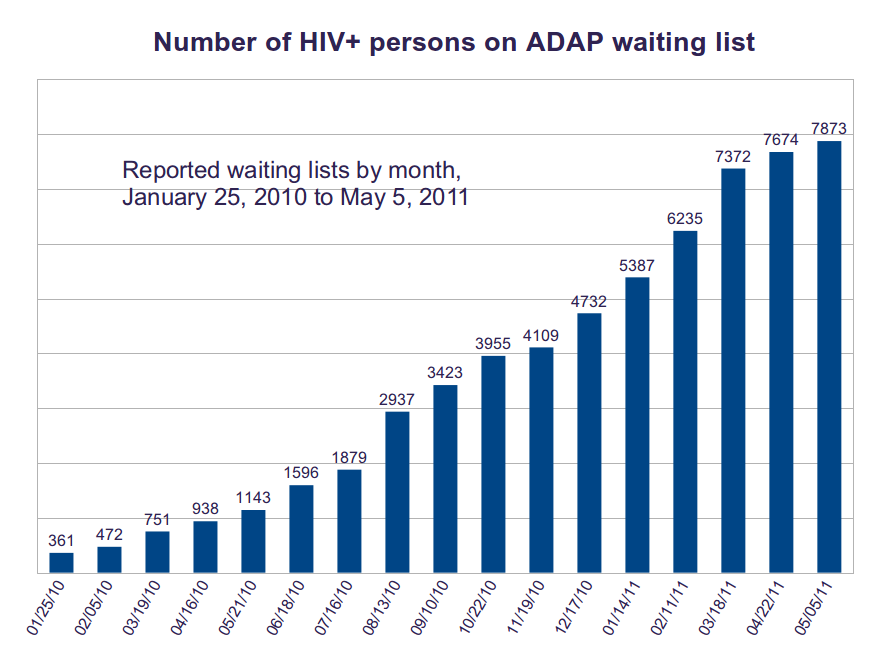 AIDS Drug Assistance Programs (ADAP) are state run programs that provide medicines to low-income HIV-positive patients who either have limited or no insurance coverage. ADAPs are essential in providing life-saving medicines to low-income patients, but these programs are threatened by the high costs of treatment.
AIDS Drug Assistance Programs (ADAP) are state run programs that provide medicines to low-income HIV-positive patients who either have limited or no insurance coverage. ADAPs are essential in providing life-saving medicines to low-income patients, but these programs are threatened by the high costs of treatment.
Despite the life-saving treatment ADAPs provide, there are currently twenty-two states plus the territory of Puerto Rico that have been forced to resort to placing AIDS patients on waiting lists, implementing various cost-containment mechanisms (or both), or are considering new or additional cost-containment measures.
In January 2010, 361 individuals were on ADAP waiting lists, meaning that 361 HIV-positive patients in the United States were being denied the life-saving treatment they need. This number has risen dramatically and as of May 5, 2011, that figure now sits at 7,873 individuals on ADAP waiting lists across eleven states including: Arkansas, Florida, Georgia, Idaho, Louisiana, Montana, North Carolina, Ohio, South Carolina, Virginia and Wyoming. This dramatic jump represents a more than 2100% increase over the course of less than sixteen months.
|
The lack of access to ARV treatments harms persons who are HIV+, and also contributes to a higher rates of infections, according to studies funded by the National Institutes of Health (NIH).
|
Not only are there nearly 8,000 AIDS patients denied necessary treatment as they sit on waiting lists, but those who do receive care under ADAPs may not be receiving the full course of treatment they need. Currently, seventeen states and Puerto Rico have resorted to cost-containment strategies including, among others, reducing formularies, lowering financial eligibility and disenrolling clients, capping enrollment, instituting monthly expenditure caps, discontinuing reimbursement of laboratory assays, and instituting client cost sharing. These cost-containment mechanisms endanger low-income AIDS patients who may not be receiving the full formularies or who cannot pay for costs above the monthly expenditure caps. Several of these states, including Arkansas, Florida, Georgia, Idaho, Louisiana, North Carolina, Ohio, South Carolina, Virginia and Wyoming implement these measures to reduce costs yet still resort to the waiting lists above. Other states using cost-containment measures include: Arizona, Colorado, Illinois, Kentucky, North Dakota, Utah and Washington.
Colorado, Florida, Illinois, Kentucky, Montana, South Carolina, Utah, Washington, Wyoming and the territory of Puerto Rico are currently considering new or additional cost-containment measures to be implemented before March 31, 2012 because, even with their current waiting lists and cost-containment strategies, they anticipate that their programs will be further impacted and that they will be unable to provide treatment for all the low-income AIDS patients that would otherwise qualify for ADAP support. An additional four states ADAPs, including Alabama, Hawaii, Oregon and Tennessee, are all considering the establishment of waiting lists or using reduced formularies.
The National Alliance of State & Territorial AIDS Directors produces regular updates called “ADAP Watch.” The most recent ADAP Watch, dated May 6, 2011, is available here.
| Date | Number of HIV+ persons |
| 10/8/2009 | 247 |
| 1/25/2010 | 361 |
| 2/5/2010 | 472 |
| 3/19/2010 | 751 |
| 4/16/2010 | 938 |
| 5/21/2010 | 1143 |
| 6/18/2010 | 1596 |
| 7/16/2010 | 1879 |
| 8/13/2010 | 2937 |
| 9/10/2010 | 3423 |
| 10/22/2010 | 3955 |
| 11/19/2010 | 4109 |
| 12/17/2010 | 4732 |
| 1/14/2011 | 5387 |
| 2/11/2011 | 6235 |
| 3/18/2011 | 7372 |
| 4/22/2011 | 7674 |
| 5/5/2011 | 7873 |